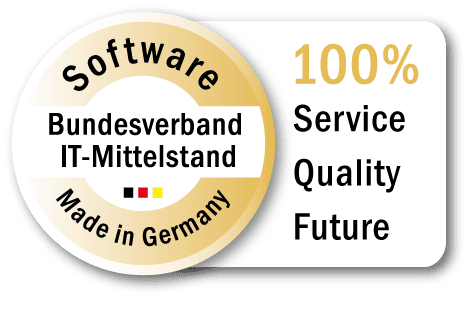In a modern factory, data is not only crucial, but also the driving factor for efficiency, productivity and innovation. The introduction of an effective data infrastructure between OT and IT plays a key role here. In this context, the concept of the Unified Namespace (UNS) is becoming increasingly important in the manufacturing industry. You can read more about UNS and its advantages here.
Important: UNS only describes the concept. You must define how the concept is implemented. By consistently implementing the following 6 steps, which are based on proven strategies from successful Industrial IoT projects, you will implement a UNS architecture with sustainable success.
1. Define goals, create clarity
Defining and communicating clear objectives for the introduction of a UNS is the fundamental first step. The formulation of concrete and measurable goals is crucial to establish a link to the company’s goals. Therefore, identify and understand the key challenges and requirements of your business areas (e.g. realizing sales growth with existing production systems). Derive targets for data management at company, business unit and operational level (e.g. standardized OEE analysis). Define priorities and set measurable targets (e.g. global increase in OEE by 15%). This is important for monitoring and reviewing your UNS pilot project at a later date.
2. Analyze data landscape & identify key stakeholders
Analyze your current data environment to uncover data sources, formats and types as well as potential integration challenges. Thereby, limit yourself to OT and IT systems that are crucial for achieving your goals from point one (1). Systems may include machines, sensors, SCADA, historians, databases, MES and ERP. Then, identify key stakeholders in your current system landscape and actively involve them in the development of your UNS strategy.
3. Define requirements for data architecture, security and infrastructure
UNS merely describes the concept. You must define how the concept is implemented. Therefore, derive the requirements for the following key components of your UNS based on your objectives defined in point one (1):
- Data architecture: defines the basic organization and flow of data
- Data security: refers to measures to ensure the confidentiality and integrity of data within the UNS and to protect it from unauthorized access or loss
- Data infrastructure: ultimately implements the data architecture and security physically by providing necessary hard- and software.
Together, these elements form the foundation of your UNS. For example, if scalability is a key requirement, implementing standardized information and data models (data architecture) becomes essential. To ensure the availability of this data within the UNS, it is encrypted and protected using multi-level access controls (data security). This requirement is met through the integration of both software and hardware components, such as cloud services, servers, and middleware (data infrastructure).
4. Form a Data Operations (DataOps) Team
Form an interdisciplinary team that represents the most important stakeholders from point two (2). Make sure that your team covers both the key areas (e.g. OT and IT) and expertise (e.g. for data security). Thereby, the team members’ expertise ensures that the UNS is implemented effectively and meets the diverse needs of your organization. The DataOps team is typically responsible for:
- Planning and strategy: Develop a clear strategy for the implementation of the Unified Namespace based on business goals and requirements.
- Architecture design: Design of the architecture of the unified namespace, including the definition of data structures, standards and integration methods.
- Data infrastructure and integration: Responsible for the actual implementation of the UNS, including integration with existing IT and OT systems.
- Security and data protection: Implementation of security measures and data protection guidelines for the Unified Namespace to ensure the integrity and confidentiality of the data.
- Internal training: Training of employees and relevant stakeholders to ensure they can efficiently operate and leverage the UNS.
- Continuous optimization: Identify optimization opportunities in the Unified Namespace and implement improvements to ensure it meets the changing needs of the business.
- Troubleshooting and support: Providing support for problems that arise in connection with the Unified Namespace and implementing solutions.
- Compliance management: Ensuring compliance with legal and regulatory requirements in connection with data management and data protection.
5. Invest in Unified Namespace (UNS) data infrastructure
A robust data infrastructure consists of software and hardware components such as on-premise and cloud services, servers and middleware (e.g. MQTT Broker). It forms the backbone of your UNS. Therefore, invest in state-of-the-art data infrastructure and make sure that your infrastructure is tailored to your specific requirements. Targeted investments allow you to meet your goals and ambitions. They provide your team with the right tools to keep your company competitive in the era of data analytics and AI.
6. Set up a Unified Namespace (UNS) pilot, convince the organization
Prioritize potential UNS use-cases based on their cost/benefit ratio. Identify a pilot use-case and monitor your pilot with regard to the defined goals from point one (1). Thereby, differentiate between improvement KPIs (e.g. OEE) and stabilization KPIs (e.g. number of faulty data points). This allows you to differentiate business success from teething troubles in your UNS pilot and make targeted adjustments. Do pioneering work and use lighthouse projects to get your organization moving. In an iterative process, your DataOps team from point 4 ensures that your UNS is constantly evolving in line with business objectives and technological progress.
Conclusion
By setting precise objectives, analyzing the status quo in detail and developing a forward-looking data architecture, security and infrastructure, you lay the foundation for the successful introduction of a Unified Namespace (UNS). The formation of an interdisciplinary DataOps team, supported by targeted investments in modern data infrastructure, maximizes your chances of success in implementation. Test and refine your strategy with a pilot project, do pioneering work and use a successful lighthouse to convince and inspire your employees.


